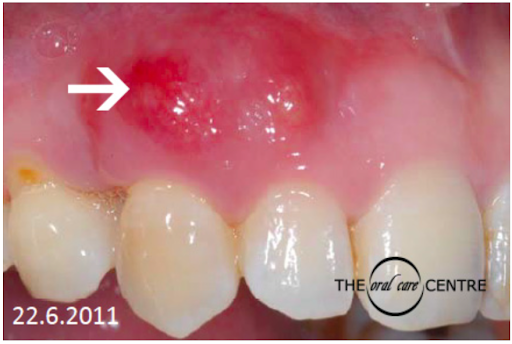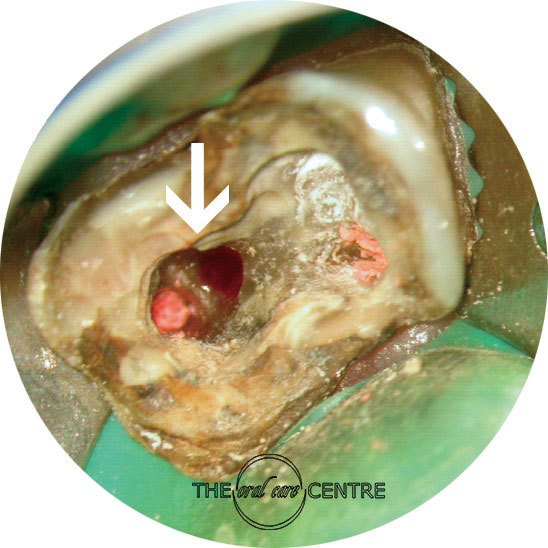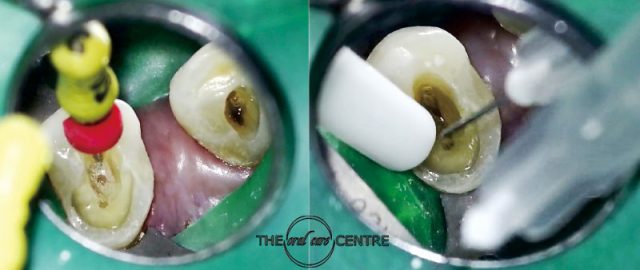Root canal treatment, a common dental procedure, is designed to save a tooth that has become infected or inflamed. This endodontic therapy involves removing the damaged pulp from inside the tooth and then cleaning and sealing the tooth to prevent further infection. Learn more about it here.
“Endo” is the Greek word for “inside” and “odont” is for “tooth.” Endodontic therapy therefore treats the inside of the tooth and root canal treatment is a type of endodontic treatment.
A root canal removes infection from inside a tooth, making it a very effective tooth pain relief treatment. Furthermore, it can also protect the tooth from future infections.
Root Canal Treatment in Singapore: When Is It Necessary?
A root canal treatment becomes necessary when the pulp inside a tooth where the nerves and blood vessels are becomes inflamed or infected.

This can happen due to various reasons like:
- Deep cavity: a deep cavity opens the pulp to inflammation or infection.
- Cracked or chipped tooth: A crack or chip can expose the pulp to bacteria, leading to infection.
- Repeated dental procedures: Having several dental procedures on the same tooth can weaken it, resulting in it being more susceptible to infection.
- Trauma: A blow to the tooth can damage the pulp, even if the tooth doesn’t chip or crack.
The following signs may indicate that someone needs endodontic therapy, specifically root canal treatment:
- Persistent and throbbing pain that worsens when chewing or biting.
- Lingering pain after exposure to hot or cold food or drinks.
- The gums around the affected tooth may be swollen, tender, or even develop a pimple-like bump.
- The tooth may become darker due to the dying pulp.
- The tooth may be sensitive to pressure.
Not everyone with these symptoms will need an endodontic therapy such as a root canal. Other dental issues can cause similar symptoms, so it’s crucial to consult a dentist for proper diagnosis and treatment.
If you experience any of these signs, it’s best to schedule an appointment with your dentist as soon as possible to prevent the infection from spreading and causing further damage. Early treatment can save the natural tooth and prevent the need for extraction.
Endodontic Therapy: What to Expect During and After
The dental procedure of an endodontic therapy (root canal) involves several steps. On top of being provided with anaesthesia, you may expect the following:
- The dentist drills a small hole in the tooth to reach the pulp chamber.
- The infected or damaged nerve, blood vessels, and tissues in the pulp are removed using specialised instruments.
- The root canals are cleaned and shaped to prepare them for filling.
- The root canals are temporarily filled with a biocompatible material, usually gutta-percha, and sealed.
- The tooth is usually restored with a crown to protect it and restore its function, although this step needs another one or two appointments.
After a root canal, the treated tooth may be sensitive for a few days, but over-the-counter pain relievers can manage any discomfort. It’s essential to refrain from chewing using the affected tooth, at least until it has been fully treated with a crown. Stick to soft foods and practise good oral hygiene by brushing gently and flossing once a day.


Root Canal Treatment Of Immature Teeth: Why It’s More Complex
Immature teeth in children and adolescents are not fully developed, and their root formation is incomplete. Therefore, they require special consideration and techniques compared to standard endodontic therapy for fully developed teeth. The goal of endodontic therapy in immature teeth is to preserve the tooth’s viability, promote continued root development, and avoid extraction.
Here’s what you need to know about the root canal treatment of immature teeth:
Challenges of Immature Teeth
- Open Apex: Immature teeth often have a large, open root apex (tip), which makes sealing the root canal challenging.
- Thin Root Walls: The root walls may be thinner and weaker, making them more susceptible to fracture or damage during the dental procedure.
- Incomplete Root Canal Formation: The pulp tissue inside the tooth may still be active, and the root may not be fully formed, leading to complications in cleaning, shaping, and filling the canal
Treatment Objectives
- Preserve the Tooth: The primary goal is to prevent the need for extraction and to preserve the tooth as a functional part of the child’s dentition.
- Promote Root Development: Unlike a fully developed tooth, the immature tooth still has the potential to continue growing, and endodontic therapy aims to encourage further root maturation.
- Achieve a Sealed Canal: A sealed root canal is needed to prevent infection and promote the tooth’s long-term survival.
Common Techniques Used in Immature Teeth
Below are the common techniques used in immature teeth, the process involved, and when they are performed:
Pulpotomy or Partial Pulpectomy
- Suppose the pulp is healthy but infected or inflamed near the apex. In that case, the following endodontic therapy may be performed: pulpotomy (removal of the coronal portion of the pulp) or partial pulpectomy (removal of the infected portion of the pulp while leaving the healthy part intact).
- This allows the healthy portion of the pulp to continue promoting root development.
Apexification
- Apexification is a dental procedure aimed at promoting the closure of the root’s apex (tip) in an immature tooth. In cases where the pulp is necrotic (dead), the dentist will induce the formation of a calcified barrier at the root tip to allow for sealing the canal.
- This dental procedure often involves placing calcium hydroxide (a material that encourages the formation of a hard tissue barrier) into the root canal over a period of time. After the barrier forms, the canal can be filled.
- Apexification is most often used when the tooth has already lost its pulp vitality but still has the potential to form a barrier at the apex.
Regenerative Endodontics (Revascularization)
- Revascularization is a dental procedure that restores blood vessels and nerves to the inner portion of a tooth, saving it from requiring endodontic therapy or being extracted. It is an alternative to the traditional apexification treatment, which involves inserting calcium hydroxide paste into the root canal.
- Revascularization or regenerative endodontic therapy (RET) is an emerging technique that aims to encourage the growth of new tissue inside the root canal by re-establishing blood flow and continual growth of the pulp tissue.
- In this procedure, the dentist cleans and disinfects the root canal. The canal is then filled with scaffold material to stimulate tissue regeneration.
- The goal is to promote healing and continued root development rather than simply sealing the canal.
Regenerative Endodontic Therapy
- Disinfection: The root canal is thoroughly cleaned and disinfected to remove bacteria or necrotic tissue.
- Apexogenesis: This dental procedure aims to preserve the vitality of the remaining pulp tissue, allowing the root to mature and close naturally. It’s often indicated when there is still a portion of viable pulp tissue.
- Scaffold Placement: Materials like platelet-rich plasma (PRP), bone morphogenetic proteins (BMPs), or collagen scaffolds are sometimes used to facilitate tissue regeneration.
- Dressing: A bioactive dressing like calcium hydroxide may be placed in the canal to encourage healing.
Materials Used
- Calcium Hydroxide: Often used for apexification and as an interim dressing material because it helps stimulate hard tissue formation and has antibacterial properties.
- Mineral Trioxide Aggregate (MTA): Used for sealing the apex after apexification or in regenerative procedures due to its excellent sealing ability and biocompatibility.
- Biodentine: A newer material that can also be used for apexification and root-end sealing, offering similar benefits to MTA.
Follow-up and Success Rates
- Regular Monitoring: Immature teeth require careful follow-up to ensure the root continues developing properly. Radiographs are often taken to monitor root formation and the closure of the apex.
- Success Rates: Success rates for regenerative endodontic therapy are relatively high, particularly when performed early and under the right conditions. Apexification has a good prognosis in many cases, especially with the use of modern biocompatible materials.
Outcomes
- Root Maturation: Regenerative endodontic therapy can lead to the continued growth of the root, thicker root walls, and the closure of the apex.
- Functional Tooth: The ultimate goal is to preserve the tooth for as long as possible, allowing it to serve the patient’s bite and function until the permanent tooth erupts.
Alternative Approaches
In some cases, if the tooth is not salvageable or root development does not occur despite treatment, the tooth may need to be extracted. However, this is typically a last resort.
Conclusion
Root canal treatment is a common and effective dental procedure that can save a tooth from extraction. It becomes necessary when the pulp inside the tooth is inflamed or infected, causing persistent pain and other symptoms. While the procedure involves several steps, it is generally safe and well-tolerated. After treatment, proper care and good oral hygiene can help ensure the long-term success of the treated tooth. If you are experiencing any symptoms of pulp inflammation or infection, consult with your dentist to determine if root canal treatment is right for you.
References:
Root Canal: Procedure, What It Treats, and Recovery, https://my.clevelandclinic.org/health/treatments/21759-root-canal Accessed October 5, 2024
What is Root Canal? https://www.aae.org/patients/root-canal-treatment/what-is-a-root-canal/ Accessed October 5, 2024
Root Canal Treatment, https://www.healthhub.sg/a-z/diseases-and-conditions/root_canal_treatment_sdhf Accessed October 5, 2024

